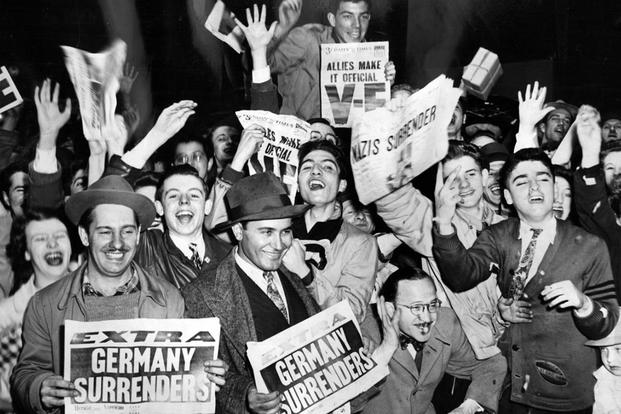On May 8, 1945, people flooded the streets, waved banners and all but mauled American troops in hugs as the Allies marked the unconditional surrender of Nazi Germany's armed forces. Having endured years of death, disaster and genocide during World War II, many Europeans and Americans could have only dreamt that such a day would arrive.
On this day in history, V-E Day, America and its allies breathed a collective sigh of relief as the bloodshed and suffering in Europe was finally ended. Hitler was dead, as were his plans for a Thousand Year Reich. Victory in Europe, at last, was realized.
Victory was never certain, as the Allies had engaged in deadly air-to-air combat against Luftwaffe, and ground forces fought their way through Nazi Panzer divisions and armored columns of divisions. Fighting had been particularly intense after the June 1944 D-Day invasion, with many lives lost.
By the beginning of April, the Allied forces had begun to see signs that the war was in its final days. It was also at this point that the Allies finally became aware of the magnitude of the atrocities perpetrated by the Nazis at concentration camps such as Ohrdruf, discovered by American troops on April 4.
According to a book titled "The Day the War Ended: May 8, 1945 - Victory in Europe," author Martin Gilbert explains that the discovery of the camps horrified Supreme Allied Commander Dwight D. Eisenhower, and he quickly alerted Congress of the grim discovery.
Throughout April, Allied forces liberated camps and sent remaining German troops scurrying.
Gilbert wrote, “On April 21, the Germans evacuated the concentration camp at Sachsenhausen, 18 miles north of Berlin, marching the inmates towards the Elbe. One of the marchers, the Czech-born Kurt Cierer, then 19, recalled, ‘We could tell the end of the war was coming; all along the way we saw signs that the German Army was crumbling.’”
Robert Oliver, Air Force Historical Support Division, told Military.com that as the grip of Allied forces tightened around Germany, the pressure became too much for Hitler to face. He died of suicide on April 30, 1945. On May 7, Hitler’s successor, Karl Donitz, signed the unconditional surrender of the Germans, to take effect on May 8, 1945, the date now known as Victory in Europe Day (V-E Day).
The years of death and destruction had taken an unimaginable toll. As news of the German surrender spread, spontaneous celebrations erupted all over the world. The New York Times headline of the day read, “End of the Ugly Dream.”
Mollie Panter-Downes, an English novelist, described the scene in London: “American sailors and laughing girls formed a conga line down the middle of Piccadilly … They were the liberated people who, like their counterparts in every celebrating capital that night, were young enough to outlive the past and to look forward to an unspoilt future.”
In New York City, massive crowds gathered in the streets, waving flags. President Harry Truman dedicated the celebrations to his predecessor, Franklin D. Roosevelt, who had died a month earlier.
While World War II would linger in the Pacific until August 1945, VE Day signaled change, relief and a major turning point for a world beleaguered by war.
This article has been updated to reflect the acceptance of Germany's unconditional surrender.
Stay on Top of Your Military Benefits
Military benefits are always changing. Keep up with everything from pay to health care by subscribing to Military.com, and get access to up-to-date pay charts and more with all latest benefits delivered straight to your inbox.















